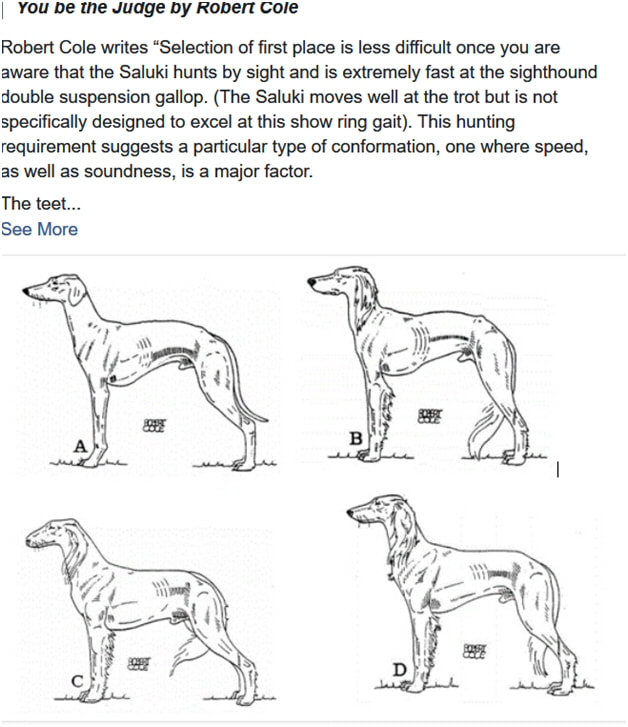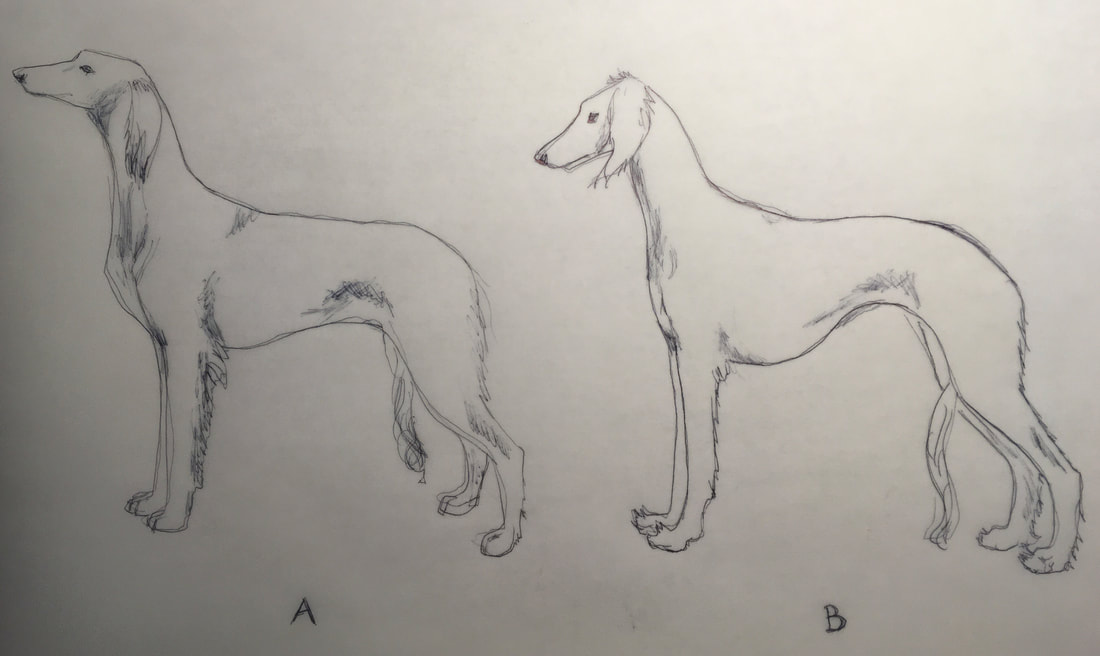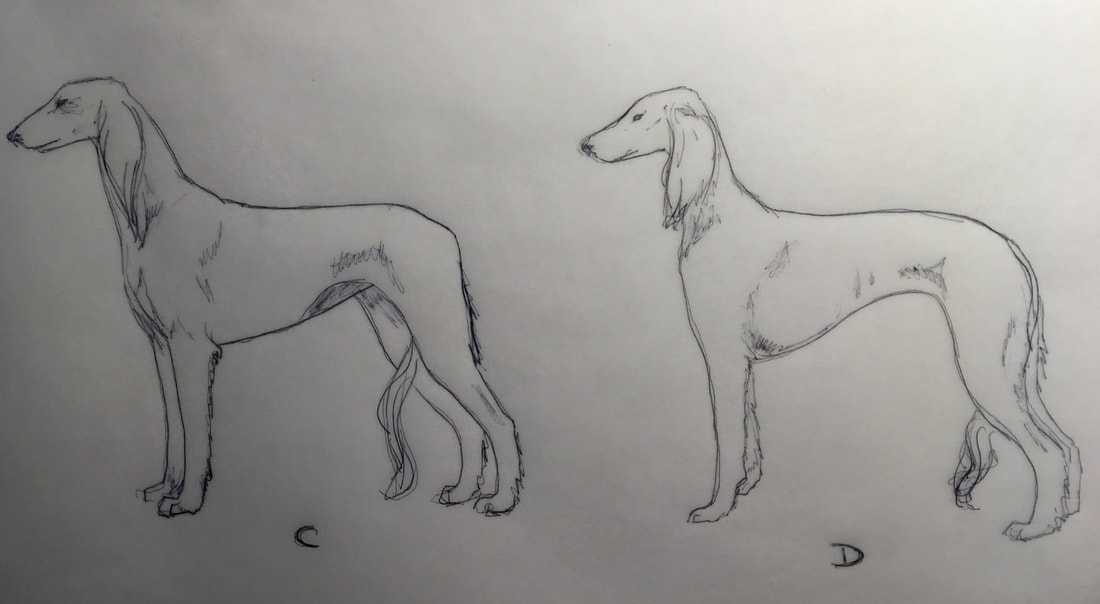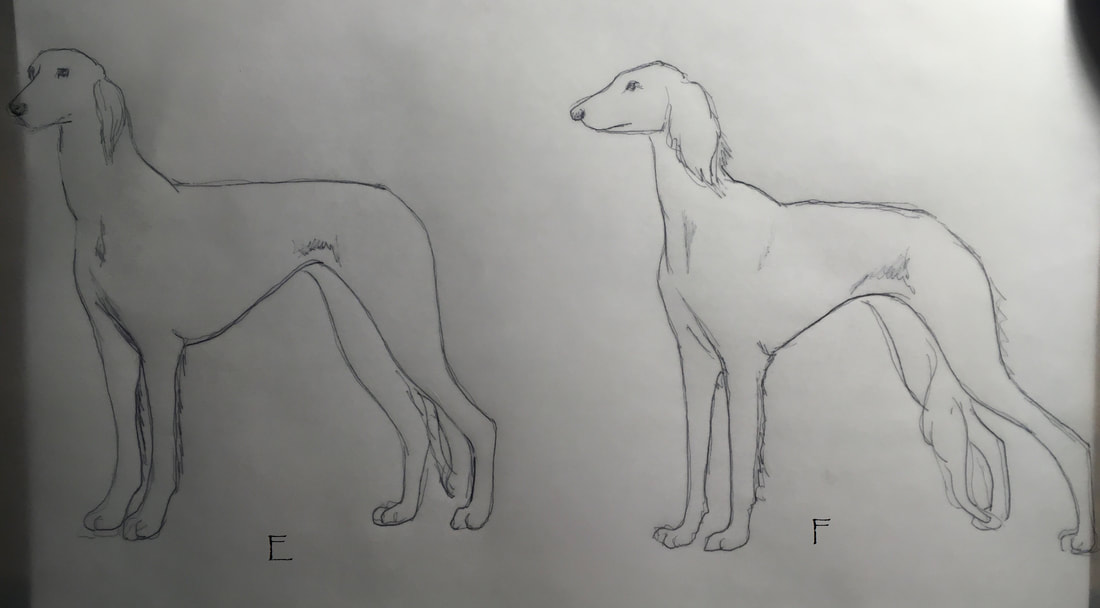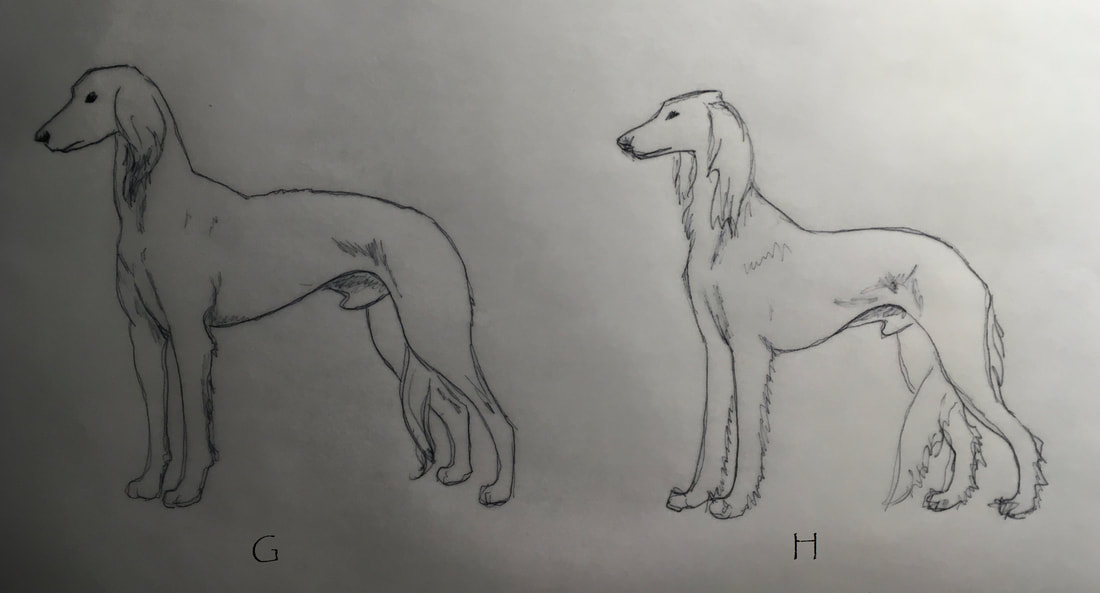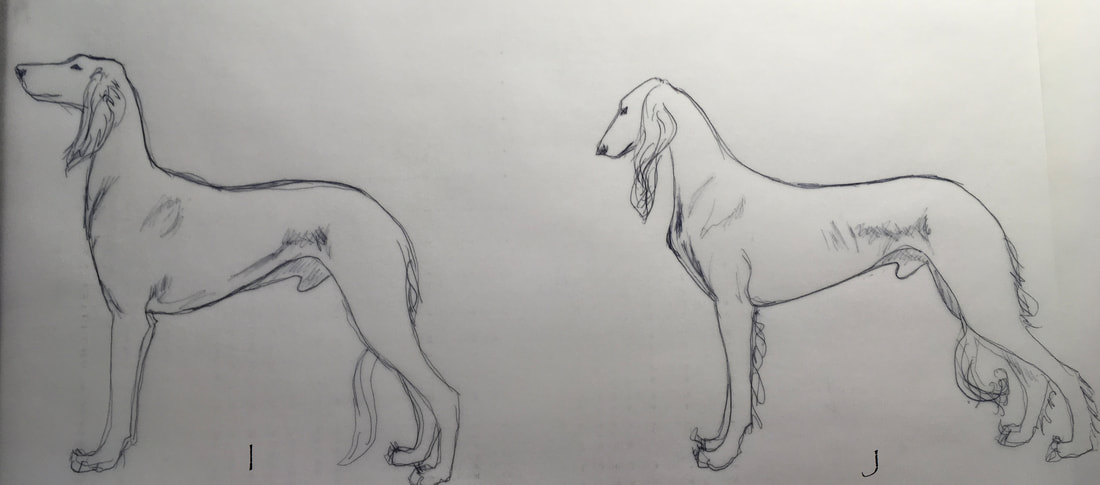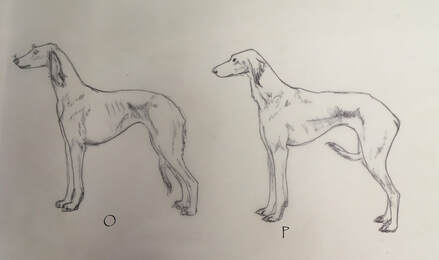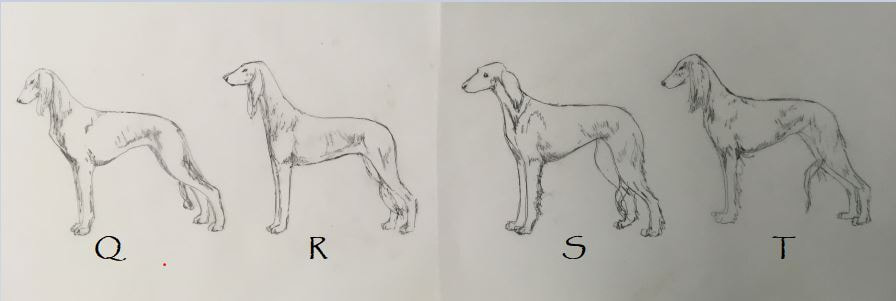Saluki Judging Tests
On this page you will find tests about the standard's wording and tests to challenge your ability to place dogs.
AKC Standard Quiz
Which of the following term or terms is NOT used in the AKC standard to describe the part mentioned? There may be more than one incorrect term.
Head:
a) long
b) narrow
c) pronounced stop
d) domed
Eyes:
a) large
b) rounded
c) triangular
d) oval
Nose:
a) black
b) liver
c) pink
Neck:
a) long
b) somewhat short
c) well-muscled
d) moderate
Chest:
a) reaches at least to or below point of elbow
b) should not reach elbow
c) well-sprung
d) moderately narrow
Forequarters:
a) shoulders sloping
b) upper arm set well under
c) well-muscled
d) inclined to be straight
Forelegs:
a) strong pasterns
b) long from elbow to knee
c) rounded bone
d) straight
Hindquarters:
a) stifle well-bent
b) stifle moderately bent
c) hipbones set well apart
d) hocks low to the ground
Loin and back:
a) back fairly narrow
b) back fairly broad
c) topline straight
d) muscles slightly arched over loin
Feet:
a) toes long and well-arched
b) cat-footed
c) well feathered between the toes
d) of moderate length
Tail:
a) long
b) set on high
c) set on low
d) carried naturally in a curve
e) never held about the level of the back
Expression:
a) piercing
b) aloof
c) dignified
d) gentle
Size:
a) dogs and bitches 23 to 28", with preference to larger size as long as symmetry is not lost
b) dogs 23 to 28" and bitches may be considerably smaller
Answers...may be found in the AKC Saluki standard below:
Official Standard of the Saluki: Head: Long and narrow, skull moderately wide between the ears, not domed, stop not pronounced, the whole showing great quality. Nose black or liver. Ears Long and covered with long silky hair hanging close to the skull and mobile. Eyes Dark to hazel and bright; large and oval, but not prominent. Teeth Strong and level. Neck: Long, supple and well muscled. Chest: Deep and moderately narrow. Forequarters: Shoulders sloping and set well back, well muscled without being coarse. Forelegs Straight and long from the elbow to the knee. Hindquarters: Strong, hipbones set well apart and stifle moderately bent, hocks low to the ground, showing galloping and jumping power. Loin and Back: Back fairly broad, muscles slightly arched over loin. Feet: Of moderate length, toes long and well arched, not splayed out, but at the same time not cat-footed; the whole being strong and supple and well feathered between the toes. Tail: Long, set on low and carried naturally in a curve, well feathered on the underside with long silky hair, not bushy. Coat: Smooth and of a soft silky texture, slight feather on the legs, feather at the back of the thighs and sometimes with slight woolly feather on the thigh and shoulder.
Head Questions:
1) When considering the head from the side, what do you look for?
2) What about eye size, shape and color?
3) Should the bite be level or scissors? Are premolars mentioned?
4) Can the nose be any color?
Answers:
1) Stop not pronounced, generally parallel planes (not in the standard), about equal length muzzle to backskull (not in the standard), flat backsull, no pronounced brow or frontal bone (not in the standard), high ear set (not in the standard), strong underjaw (not in the standard).
2) Large, oval, dark to hazel (hazel is to accommodate liver dogs, not to excuse light eyes)
3) The standard says "Teeth level" but the bite should be scissors. Premolars are not mentioned.
4) It can be black or liver. Not pink, not multi-colored (some leeway given for grizzles with striped noses). Liver is to accommodate liver dogs.
Fill in the blanks:
Head: Long and _____, skull moderately _____ between the ears, not _____, _____not pronounced, the whole showing great quality.
Nose black or _____.
Ears ____ and covered with long silky hair hanging close to the skull and _____.
Eyes Dark to hazel and bright; ____and ___, but not prominent.
Teeth Strong and level.
Neck: ____, supple and well muscled.
Chest: Deep and moderately ______.
Forequarters: Shoulders sloping and set _________, well muscled without being coarse.
Forelegs Straight and ____ from the elbow to the knee.
Hindquarters: Strong, _______set well apart and stifle _______ bent, hocks low to the ground, showing galloping and jumping power
Loin and Back: Back fairly ______, muscles slightly _____over loin.
Feet: Of ______length, toes long and well arched, not splayed out, but at the same time not ____-footed; the whole being strong and supple and well ______ between the toes.
Tail: Long, set on ____ and carried naturally in _ ______, well feathered on the underside with long silky hair, not _____.
Coat: Smooth and of a ___ ____ texture, slight feather on the legs, feather at the back of the thighs and sometimes with slight woolly feather on the thigh and shoulder.
Colors: White, cream, fawn, golden, red, grizzle and tan, tricolor (white, black and tan) and black and tan.
General Appearance: The whole appearance of this breed should give an impression of ____ and symmetry and of great _____ and ______coupled with _______and activity to enable it to kill gazelle or other quarry over deep sand or rocky mountains. The expression should be ________and ______ with deep, faithful, far-seeing eyes.
Dogs should average in height from ___to ___ inches and bitches may be considerably smaller, this being very typical of the breed.
The Smooth Variety: In this variety the points should be the same with the exception of the coat, which has no feathering.
Consult the standard above for the answers.
AKC Standard Quiz
Which of the following term or terms is NOT used in the AKC standard to describe the part mentioned? There may be more than one incorrect term.
Head:
a) long
b) narrow
c) pronounced stop
d) domed
Eyes:
a) large
b) rounded
c) triangular
d) oval
Nose:
a) black
b) liver
c) pink
Neck:
a) long
b) somewhat short
c) well-muscled
d) moderate
Chest:
a) reaches at least to or below point of elbow
b) should not reach elbow
c) well-sprung
d) moderately narrow
Forequarters:
a) shoulders sloping
b) upper arm set well under
c) well-muscled
d) inclined to be straight
Forelegs:
a) strong pasterns
b) long from elbow to knee
c) rounded bone
d) straight
Hindquarters:
a) stifle well-bent
b) stifle moderately bent
c) hipbones set well apart
d) hocks low to the ground
Loin and back:
a) back fairly narrow
b) back fairly broad
c) topline straight
d) muscles slightly arched over loin
Feet:
a) toes long and well-arched
b) cat-footed
c) well feathered between the toes
d) of moderate length
Tail:
a) long
b) set on high
c) set on low
d) carried naturally in a curve
e) never held about the level of the back
Expression:
a) piercing
b) aloof
c) dignified
d) gentle
Size:
a) dogs and bitches 23 to 28", with preference to larger size as long as symmetry is not lost
b) dogs 23 to 28" and bitches may be considerably smaller
Answers...may be found in the AKC Saluki standard below:
Official Standard of the Saluki: Head: Long and narrow, skull moderately wide between the ears, not domed, stop not pronounced, the whole showing great quality. Nose black or liver. Ears Long and covered with long silky hair hanging close to the skull and mobile. Eyes Dark to hazel and bright; large and oval, but not prominent. Teeth Strong and level. Neck: Long, supple and well muscled. Chest: Deep and moderately narrow. Forequarters: Shoulders sloping and set well back, well muscled without being coarse. Forelegs Straight and long from the elbow to the knee. Hindquarters: Strong, hipbones set well apart and stifle moderately bent, hocks low to the ground, showing galloping and jumping power. Loin and Back: Back fairly broad, muscles slightly arched over loin. Feet: Of moderate length, toes long and well arched, not splayed out, but at the same time not cat-footed; the whole being strong and supple and well feathered between the toes. Tail: Long, set on low and carried naturally in a curve, well feathered on the underside with long silky hair, not bushy. Coat: Smooth and of a soft silky texture, slight feather on the legs, feather at the back of the thighs and sometimes with slight woolly feather on the thigh and shoulder.
Head Questions:
1) When considering the head from the side, what do you look for?
2) What about eye size, shape and color?
3) Should the bite be level or scissors? Are premolars mentioned?
4) Can the nose be any color?
Answers:
1) Stop not pronounced, generally parallel planes (not in the standard), about equal length muzzle to backskull (not in the standard), flat backsull, no pronounced brow or frontal bone (not in the standard), high ear set (not in the standard), strong underjaw (not in the standard).
2) Large, oval, dark to hazel (hazel is to accommodate liver dogs, not to excuse light eyes)
3) The standard says "Teeth level" but the bite should be scissors. Premolars are not mentioned.
4) It can be black or liver. Not pink, not multi-colored (some leeway given for grizzles with striped noses). Liver is to accommodate liver dogs.
Fill in the blanks:
Head: Long and _____, skull moderately _____ between the ears, not _____, _____not pronounced, the whole showing great quality.
Nose black or _____.
Ears ____ and covered with long silky hair hanging close to the skull and _____.
Eyes Dark to hazel and bright; ____and ___, but not prominent.
Teeth Strong and level.
Neck: ____, supple and well muscled.
Chest: Deep and moderately ______.
Forequarters: Shoulders sloping and set _________, well muscled without being coarse.
Forelegs Straight and ____ from the elbow to the knee.
Hindquarters: Strong, _______set well apart and stifle _______ bent, hocks low to the ground, showing galloping and jumping power
Loin and Back: Back fairly ______, muscles slightly _____over loin.
Feet: Of ______length, toes long and well arched, not splayed out, but at the same time not ____-footed; the whole being strong and supple and well ______ between the toes.
Tail: Long, set on ____ and carried naturally in _ ______, well feathered on the underside with long silky hair, not _____.
Coat: Smooth and of a ___ ____ texture, slight feather on the legs, feather at the back of the thighs and sometimes with slight woolly feather on the thigh and shoulder.
Colors: White, cream, fawn, golden, red, grizzle and tan, tricolor (white, black and tan) and black and tan.
General Appearance: The whole appearance of this breed should give an impression of ____ and symmetry and of great _____ and ______coupled with _______and activity to enable it to kill gazelle or other quarry over deep sand or rocky mountains. The expression should be ________and ______ with deep, faithful, far-seeing eyes.
Dogs should average in height from ___to ___ inches and bitches may be considerably smaller, this being very typical of the breed.
The Smooth Variety: In this variety the points should be the same with the exception of the coat, which has no feathering.
Consult the standard above for the answers.
Here's a link to Nikki Riggsbee's Breed Priorities article on Salukis
And from Robert Cole's You Be the Judge:
And from Robert Cole's You Be the Judge:
My comments: D: The clear winner, a decent saluki but not a great one. I'd like a bit more arch to his loin, a bit longer neck. a bit flatter bone to his forelegs, a bit longer tail, a bit longer foot, higher ear set. He may have a bit too much forechest for me. Just doesn't flow as much as I would prefer. The front is rather working dog like--maybe the shoulder is too far forward, with too much set under.
A: Reluctantly. A really bad saluki because he looks like a whippet. Topline too arched, starting to far forward. Chest cuts up too soon. No underjaw. But I prefer his front angles and set-under to that of D, and his foot length as well. Pasterns lean toward to sloping. Tail set may be high. Tail is too short. Ear set is better. Neck into withers is somewhat abrupt. A & B could change places.
B: Please let me withhold. Overly arched stiff topline, straight rear, straight front, upright forward set shoulders, ewe neck. Steep croup. Best tail though! Overly defined stop. Short round feet.
C: Last place. Where to begin? Flat topline. Too much forechest, too much chest, front set under too much. No tuck up. Round bone, round feet. Head downfaced, no stop, low ears. Short tail, May be a bit long in second though. But his rear is OK. It's this dog's torso that will preclude him from doing a good double-suspension gallop, and his head from claiming to be a saluki. Let me add: I am probably harder on this dog than I could be because I would fear that some judges would see his faults as virtues.
The following is my own little pretend saluki shows. The outlines are composites of several dogs, and do not depict any actual individuals.
Choose A versus B of these two adult bitches. Explain your choices:
A: Reluctantly. A really bad saluki because he looks like a whippet. Topline too arched, starting to far forward. Chest cuts up too soon. No underjaw. But I prefer his front angles and set-under to that of D, and his foot length as well. Pasterns lean toward to sloping. Tail set may be high. Tail is too short. Ear set is better. Neck into withers is somewhat abrupt. A & B could change places.
B: Please let me withhold. Overly arched stiff topline, straight rear, straight front, upright forward set shoulders, ewe neck. Steep croup. Best tail though! Overly defined stop. Short round feet.
C: Last place. Where to begin? Flat topline. Too much forechest, too much chest, front set under too much. No tuck up. Round bone, round feet. Head downfaced, no stop, low ears. Short tail, May be a bit long in second though. But his rear is OK. It's this dog's torso that will preclude him from doing a good double-suspension gallop, and his head from claiming to be a saluki. Let me add: I am probably harder on this dog than I could be because I would fear that some judges would see his faults as virtues.
The following is my own little pretend saluki shows. The outlines are composites of several dogs, and do not depict any actual individuals.
Choose A versus B of these two adult bitches. Explain your choices:
Here are some hints. Consider the silhouette. Compare topline and underline. Forechest? Angulaton? Now to the details: Pasterns? Feet? Tail? Ear set? Head planes? Stop? Underjaw?
Bitch B is the clear winner, although Bitch A could appeal to somebody looking from a more generic viewpoint. Topline: Bitch A is too flat, Bitch B has a slight rise over the loin. Underline: Bitch A is lacking tuck; Bitch B has plenty. Forechest: Bitch A has an atypical prow; Bitch B has a muscular fill. Angulation: Bitch A is bordering on too much return of upper arm, but I think it's OK. Bitch B is bordering on not enough return, but again is fine and I think preferable to A. Both have good rear angulation. Pasterns: Bitch A is straight; Bitch B has a slight slope. Feet: Bitch A appears to have cat feet, with no foot feathering; Bitch B has longer well-feathered feet. Tail: Bitch A has a short tail; Bitch B has a long tail. Ears: Bitch A has low set ears; Bitch B high (preferable). Head planes: Bitch A has non-parallel planes; Bitch B has parallel planes (preferable). Stop: Bitch A has a pronounced stop; Bitch B does not. Underjaw: Bitch A lacks underjaw; Bitch B has a strong underjaw.
Bitch B is the clear winner, although Bitch A could appeal to somebody looking from a more generic viewpoint. Topline: Bitch A is too flat, Bitch B has a slight rise over the loin. Underline: Bitch A is lacking tuck; Bitch B has plenty. Forechest: Bitch A has an atypical prow; Bitch B has a muscular fill. Angulation: Bitch A is bordering on too much return of upper arm, but I think it's OK. Bitch B is bordering on not enough return, but again is fine and I think preferable to A. Both have good rear angulation. Pasterns: Bitch A is straight; Bitch B has a slight slope. Feet: Bitch A appears to have cat feet, with no foot feathering; Bitch B has longer well-feathered feet. Tail: Bitch A has a short tail; Bitch B has a long tail. Ears: Bitch A has low set ears; Bitch B high (preferable). Head planes: Bitch A has non-parallel planes; Bitch B has parallel planes (preferable). Stop: Bitch A has a pronounced stop; Bitch B does not. Underjaw: Bitch A lacks underjaw; Bitch B has a strong underjaw.
Now on to these two bitches:
D is superior in a number of ways. She has a racy curvy outline without being roached or whippety. Notice the slightly arched loin, the well tucked up abdomen. Bitch C has a generic underline wit h a straight topline and very little tuck. C is doggy. C also has short front legs, although not terrible. D is admittedly a bit straight in front, with it set on too forward, but she still has more breed type. In addition, although D's head is bordering on being overly heavy, its planes are correct, whereas C has a downface with too much fill between the eyes.
What about B versus D?
I would choose B based on her better front set, better head for her sex, higher ear set and larger feet. These are both nice bitches.
What about A versus C?
This is tough. They are both very bad. Maybe A because she at least looks like she could flex and run. But that prow! And those feet! But C's Roman head and short front legs! Really both are about equally bad---just pick your poison.
So far I order them B, D, A and C.
What about bitches E and F?
What about B versus D?
I would choose B based on her better front set, better head for her sex, higher ear set and larger feet. These are both nice bitches.
What about A versus C?
This is tough. They are both very bad. Maybe A because she at least looks like she could flex and run. But that prow! And those feet! But C's Roman head and short front legs! Really both are about equally bad---just pick your poison.
So far I order them B, D, A and C.
What about bitches E and F?
Bitch E is doggy, has short front legs, a weak rear, domed head, low ear set, round eye and an ewe neck. Her elbows appear to be set under too far, But she has a decent topline and tuck. Bitch F has a down face, no underjaw, lumpy withers, weedy rear with overlong second thigh, herring gutted. I prefer her feet. She is actually too tall for her length of body. I would place them E over F, although F's slighter bone and raciness is more my personal preference. But the rear would do me in...
How would you place them against the other four bitches?
I place them B, D, E, F, A, C
How would you place them against the other four bitches?
I place them B, D, E, F, A, C
Compare these two males:
Let's compare them part by part. But first, overall, do they give you the general impression of "grace and symmetry and of great speed and endurance coupled with strength and activity to enable it to kill gazelle or other quarry over deep sand or rocky mountains?" Dog H wins in the grace and symmetry department, Dog G in the strength department.
Proportion: Dog G is a little long but not terribly. Dog H is a bit short coupled.
Head: Dog G has a blocky rather coarse head with a pronounced stop. His head appears domed and without parallel planes. His eye appears round. Dog H has a long head with a stop, but not pronounced stop. His backskull is flat and planes parallel. His eye may be slightly small.
Neck: Both appear to have long supple necks. Dog G's neck joins the withers abruptly though.
Topline: Dog G is rough over the withers, He has an arched topline, but it starts to far forward and appears to be a hard rather than flexible arch. Dog H has a smoother transition and topline, but may be a bit short in back.
Underline: Dog G has a tubular chest, long but not very deep, Dog H has a nicely shaped and proportioned chest.
Front: Dog G's front is set too far forward, into his neck and leaving a cave between the forearms. He appears short from elbow to pastern. Nice slope of pastern. Round feet, no feathering. Dog H has nicely positioned and angulated front, fairly even with the forechest. Maybe down in pasterns a bit.
Rear: Dog G is verging on being too straight, with a short thin second thigh.
Tail: Both have nice tails.
My choice (by a large margin): Dog H, based on topline, head, front and underline.
For the next two, write your comments and comparisons for
Proportion:
Topline:
Underline:
Head:
Front:
Rear:
How would you place them, and why?
Proportion: Dog G is a little long but not terribly. Dog H is a bit short coupled.
Head: Dog G has a blocky rather coarse head with a pronounced stop. His head appears domed and without parallel planes. His eye appears round. Dog H has a long head with a stop, but not pronounced stop. His backskull is flat and planes parallel. His eye may be slightly small.
Neck: Both appear to have long supple necks. Dog G's neck joins the withers abruptly though.
Topline: Dog G is rough over the withers, He has an arched topline, but it starts to far forward and appears to be a hard rather than flexible arch. Dog H has a smoother transition and topline, but may be a bit short in back.
Underline: Dog G has a tubular chest, long but not very deep, Dog H has a nicely shaped and proportioned chest.
Front: Dog G's front is set too far forward, into his neck and leaving a cave between the forearms. He appears short from elbow to pastern. Nice slope of pastern. Round feet, no feathering. Dog H has nicely positioned and angulated front, fairly even with the forechest. Maybe down in pasterns a bit.
Rear: Dog G is verging on being too straight, with a short thin second thigh.
Tail: Both have nice tails.
My choice (by a large margin): Dog H, based on topline, head, front and underline.
For the next two, write your comments and comparisons for
Proportion:
Topline:
Underline:
Head:
Front:
Rear:
How would you place them, and why?
Proportion: Dog I has better proportions, being near square or a little longer than tall. Dog J appears very long, but actually he is just a bit longer than tall, and his legs are actually plenty long. His tubular shape, along with prominent prow, gives him this appearance. But Dog I wins this category.
Topline: Dog I has a slight (verging on too much) arch over the loin, but it's a bit far back making him seem almost high in rear, or rumpy. Dog J is flat (or even concave). He looks high in the rear only because he's posed on HigherGround in the rear. This category goes to Dog I.
Underline: Dog I has more definition of chest and tuck; Dog J tends to be tubular. Dog I wins.
Head: Dog I has parallel planes, a strong underjaw and good proportions. But he is verging on having too much stop, and his backskull has an overdeveloped frontal bone, and the whole picture is not very pleasing. Dog J's are not parallel, and his muzzle may be the tiniest bit longer than his backskull, but overall the look is more pleasing. I will give this category to Dog J.
Front: Both dogs have nice shoulders, although Dog J's is marred by the prow. Dog J is better neck into shoulders. If you disregard the prow I'd go with Dog J; add it in then it's dog I.
Rear: I am fine with either dog's rear. Dog I fits the standard better as the stifle is "moderately bent."
Overall, I would place them I first and J second, based mostly on the body shape and undesirable prow.
Next class:
Topline: Dog I has a slight (verging on too much) arch over the loin, but it's a bit far back making him seem almost high in rear, or rumpy. Dog J is flat (or even concave). He looks high in the rear only because he's posed on HigherGround in the rear. This category goes to Dog I.
Underline: Dog I has more definition of chest and tuck; Dog J tends to be tubular. Dog I wins.
Head: Dog I has parallel planes, a strong underjaw and good proportions. But he is verging on having too much stop, and his backskull has an overdeveloped frontal bone, and the whole picture is not very pleasing. Dog J's are not parallel, and his muzzle may be the tiniest bit longer than his backskull, but overall the look is more pleasing. I will give this category to Dog J.
Front: Both dogs have nice shoulders, although Dog J's is marred by the prow. Dog J is better neck into shoulders. If you disregard the prow I'd go with Dog J; add it in then it's dog I.
Rear: I am fine with either dog's rear. Dog I fits the standard better as the stifle is "moderately bent."
Overall, I would place them I first and J second, based mostly on the body shape and undesirable prow.
Next class:

This class of three has one easy choice and one hard choice. Last place should be obvious. Which one, and why?
Last place is M, because of being taller than long, table-top flat topline, herring gut, overdone and weak rear, and coarse downface. No feathering on feet, but not a huge deal.
K and L are both very nice. L is slightly longer, but still OK, though I prefer K's proportion. Both have very nice head, with L's being a bit more powerful, K a bit more elegant. K's eye is a little larger, which I prefer. Both have nice necks, but I prefer K's as L's is a bit thick. Both have a slight arch over the loin. Both have nice fronts, but L is set on a bit forward. Both have nice chests; L's is a bit shapelier. I prefer L's croup and also his rear angulation and lower hocks. I prefer K's overall size and grace. But based mostly on the croup, I place them L, K and M. Or K, L and M! I keep changing my mind!
Now let's compare between classes. Let's bring L, I and H back in. It is between L and H. They are close, but I choose H based on neck, proportion and my personal preference for a more elegant style. You could choose either of these two and be correct.
Ranking all the dogs, from first to last, I place them: H, L, K, I, J, G, M.
Now for Best of Breed: Dog H versus Bitch B: Dog H based on better front.
** Check back often as I will be adding new comparisons as time permits.**
Last place is M, because of being taller than long, table-top flat topline, herring gut, overdone and weak rear, and coarse downface. No feathering on feet, but not a huge deal.
K and L are both very nice. L is slightly longer, but still OK, though I prefer K's proportion. Both have very nice head, with L's being a bit more powerful, K a bit more elegant. K's eye is a little larger, which I prefer. Both have nice necks, but I prefer K's as L's is a bit thick. Both have a slight arch over the loin. Both have nice fronts, but L is set on a bit forward. Both have nice chests; L's is a bit shapelier. I prefer L's croup and also his rear angulation and lower hocks. I prefer K's overall size and grace. But based mostly on the croup, I place them L, K and M. Or K, L and M! I keep changing my mind!
Now let's compare between classes. Let's bring L, I and H back in. It is between L and H. They are close, but I choose H based on neck, proportion and my personal preference for a more elegant style. You could choose either of these two and be correct.
Ranking all the dogs, from first to last, I place them: H, L, K, I, J, G, M.
Now for Best of Breed: Dog H versus Bitch B: Dog H based on better front.
** Check back often as I will be adding new comparisons as time permits.**
Place and critique this class of six bitches.
If you chose any but O or T for first, you're in trouble. O is powerful, moderately angulated, nice neck and head, nice underline, a bit too much arch in the topline and too steep a croup, and actually a tad too tall for her height, but she is a nice athletic bitch. T is balanced, has just the right amount of front angulation, good proportion, nice slight arch to loin, long tail, decent head panes, decent underline (a bit more tuck would be nice). I prefer the smoother lines and more grace of T, so she is my choice for first (assuming movement bears it out) but many other saluki exhibitors would prefer O, who is my second place.
P is my last place. Yes, she has some nice things: strong head, good tuck, pretty good front, but they cannot make up for the rough overall lines, steep croup, short neck, lumpy withers, tucked short tail, overly pronounced stop and flat feet.
Q and R are both stylish and eye-catching. Both have very bad fronts.
Q is way overdone, with a prow and an upper arm set way too far under her. Her rear is too long for her front, which is why it is overstretched behind her, in turn making her croup too steep and topline fall away too much. I do like her underline (best in the class), neck and head.
R's front is way too straight, with a column front resulting from too little return of upper arm. I prefer her stronger rear, but her neck is too long, she lacks a tuck up, and she seems doggy. Her feet are too small.
S looks sad, but isn't actually a bad dog. She has the proper amount of front angulation and forechest. Her rear is balanced. She has the best pasterns in the class. Her neck seems slightly short, but her lack of attitude contributes to this. I'm not a fan of her round eye or straight topline, and she definitely needs more tuck up.
But I would place them T, O, S, R, Q, P. Maybe once they move some will look better. Or worse.
By the way, T is now my overall Best of Breed.
If you chose any but O or T for first, you're in trouble. O is powerful, moderately angulated, nice neck and head, nice underline, a bit too much arch in the topline and too steep a croup, and actually a tad too tall for her height, but she is a nice athletic bitch. T is balanced, has just the right amount of front angulation, good proportion, nice slight arch to loin, long tail, decent head panes, decent underline (a bit more tuck would be nice). I prefer the smoother lines and more grace of T, so she is my choice for first (assuming movement bears it out) but many other saluki exhibitors would prefer O, who is my second place.
P is my last place. Yes, she has some nice things: strong head, good tuck, pretty good front, but they cannot make up for the rough overall lines, steep croup, short neck, lumpy withers, tucked short tail, overly pronounced stop and flat feet.
Q and R are both stylish and eye-catching. Both have very bad fronts.
Q is way overdone, with a prow and an upper arm set way too far under her. Her rear is too long for her front, which is why it is overstretched behind her, in turn making her croup too steep and topline fall away too much. I do like her underline (best in the class), neck and head.
R's front is way too straight, with a column front resulting from too little return of upper arm. I prefer her stronger rear, but her neck is too long, she lacks a tuck up, and she seems doggy. Her feet are too small.
S looks sad, but isn't actually a bad dog. She has the proper amount of front angulation and forechest. Her rear is balanced. She has the best pasterns in the class. Her neck seems slightly short, but her lack of attitude contributes to this. I'm not a fan of her round eye or straight topline, and she definitely needs more tuck up.
But I would place them T, O, S, R, Q, P. Maybe once they move some will look better. Or worse.
By the way, T is now my overall Best of Breed.
